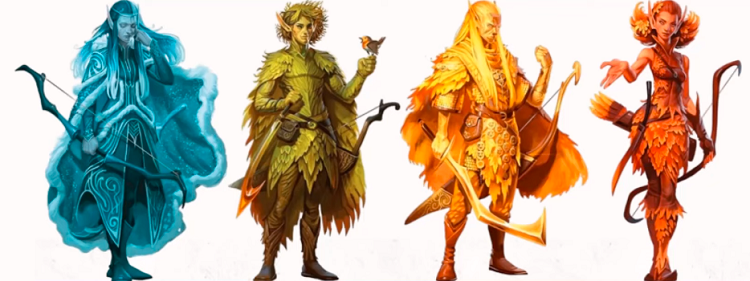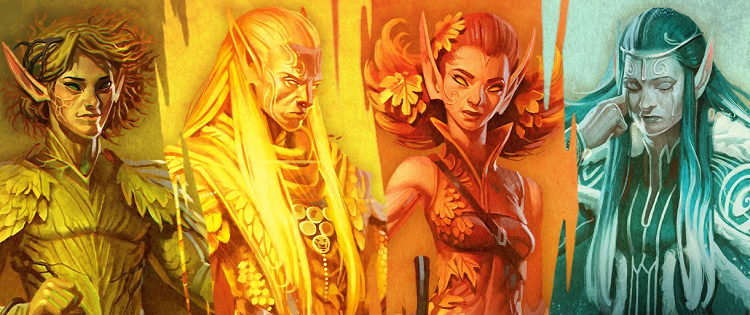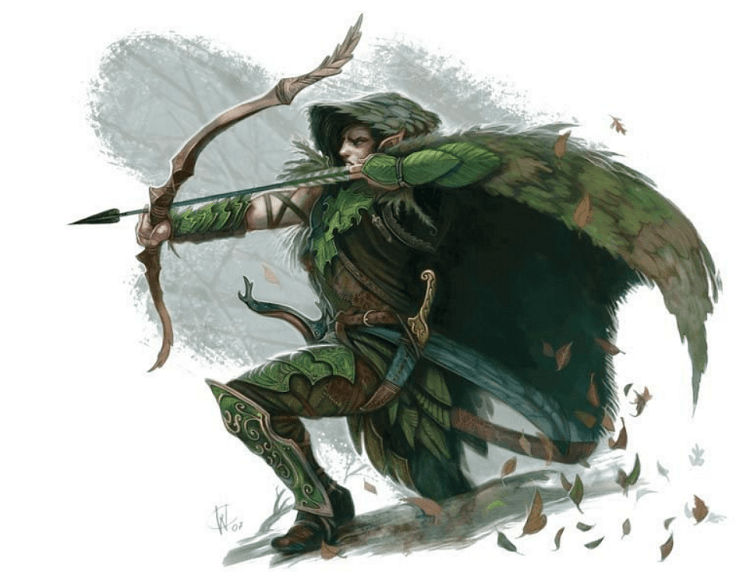An Eladrin 5e guide is something I looked into when the new Eladrin from Monsters of the Multiverse came out. Because I love Elves of all kinds, the Eladrin truly spoke to me and my DnD choices.
While Eladrin are often associated with contempt, Rogues in DnD are also often associated with dirty deeds. I avoid both and yet prefer to be an Elf (of some sort) Rogue in most DnD campaigns.
Eladrin 5e – Wrapped Up
Before 5e was released, eladrin was just an archaic way to say High Elf. It wasn’t exactly a proper noun like it is now, but a simple term used to describe various fey creatures, especially the High Elf.
Today, Eladrin are a specific type of Elf that are often seen as the oldest Elven subrace in the entire multiverse. They are each connected to the season that is active and have all of the same traits that an Elf does.
Eladrin From Mordenkainen’s Tome of Foes
The first time that Eladrin got a considerable upgrade with details for the player race was in Mordenkainen’s Tome of Foes in 2018. The Eladrin in Tome of Foes are magical, unpredictable, and emotional.
- Ability Score Increase – Dexterity by 2, Charisma by 1
- Age – Adulthood at 100, lives to be around 750
- Size – Medium
- Speed – 30
- Languages – Common, Elven
- Gain – Darkvision, Fey Ancestry, Trance, Keen Senses, Fey Step
Eladrin from Monsters of the Multiverse

There are very few differences between the Eladrin from Mordenkainen’s Tome of Foes and Monsters of the Multiverse. This is likely because Mordenkainen also made Monsters of the Multiverse.
- Ability Score Increase – One by 2, and one by 1 (or three by 1)
- Age – Adulthood at 100, lives to be around 750
- Size – Medium
- Speed – 30
- Languages – Common and one other you and the DM agree on
- Gain – Darkvision, Fey Ancestry, Trance, Keen Senses, Fey Step
Eladrin Traits and Abilites
The Eladrin has nearly identical traits to the Elf. But if you’re new – or need a refresher – you can check out a breakdown of these traits and how to make the most of them in your campaign.
Darkvision
Darkvision gives the Eladrin full vision in dim light within 60 feet of them. In the darkness, it appears as if there is a dim light lit in the area. However, colors are seen as shades of gray in the dark.
Fey Ancestry
The most straightforward trait is Fey Ancestry, which grants you an advantage on saving throws that you roll to avoid or end the charmed condition on yourself. So you can resist charms with an advantage.
Trance
In the latest version, Trance is a bit complicated. It doesn’t just mean that you don’t have to sleep but can meditate for four hours. Now, it means you get a bonus for doing so.
After each trance, you can change your season and gain (temporarily) two proficiencies with a weapon or tool of your choice (PHB only). You retain them until your next long rest.
Keen Senses
This is simply the added proficiency in the Perception skill. If you already have proficiency in Perception, the DM may allow you to switch it out for something else or grant you double proficiency.
Fey Step
The base of this ability is a bonus action that allows you to transport 30 feet away to a vacant spot. You can do this once per rest (even a short one), and there is an added seasonal ability.
Eladrin Seasonal Changes

In the autumn, they are peaceful and generous. In the winter, they are thoughtful and conservative. In the spring, they are joyful and love to party. Then, in the summer, they are aggressive and daring.
While most Eladrin change with the seasons, some attach themselves to one season for their entire life. After each long rest, the Eladrin can change which season to harness. This can be for any reason.
However, the weather can affect their mood just as much as their mood can affect the season they connect with.
Fey Step with Season Change
When you reach 3rd level, you can use Fey Step with an added seasonal ability. Your DC for the effect is 8 + your proficiency bonus + your Intelligence, Wisdom, or Charisma modifier.
Choose the modifier when you create your character. You must also use the ability that is attached to the season you are currently in. Psychologically and spiritually, of course.
Autumn
When you use Fey Step, up to two creatures of your choice that are within 10 feet (and that you can see) must succeed on a Wisdom saving throw. If they fail, they are charmed for one minute.
The charm is broken if you are your companions do any damage to the creature.
Winter
When you use your Fey Step, a creature that you can see within 5 feet of you (before the step) must succeed on a Wisdom saving throw. If they fail, they are then frightened of you until the end of your next turn.
Spring
When you use Fey Step, you can touch one creature within 5 feet of you. That creature teleports instead of you to a vacant spot within 30 feet of you. The creature must be willing.
Summer
When you use Fey Step, each creature that you can see within 5 feet – that you choose – takes fire damage equal to your proficiency bonus. You can choose only enemies as it isn’t an area of effect attack.
Personality Changes for the Eladrin

While you don’t have to change your personality, it’s part of the roleplaying game to do so. Depending on which season you’re harnessing, your personality should change. Here’s something to work with as far as mood is concerned.
Spring – Did Somebody Say Mead?
The spring Eladrin is happy-go-lucky. Every day is an adventure. Most spring Eladrin love to keep moving, play music, and party. This is one of their flaws, considering they are prone to socially-fueled addictions.
They often love to drink and can be as flirty as a Bard. If you’re a spring Eladrin (or in the spring mood), use joy as your primary attribute and work around it.
Summer – Violence to End Violence
The summer Eladrin is fierce. Every day is a battle. This isn’t always bad because it makes them determined – even for good. But it can get them into trouble as they often like to start fights.
If you’re a summer Eladrin, focus on resolve. This is your best and worst trait – the one that fuels you. You are probably bold, honest, and have a will that no one can break.
Winter – Only the Strongest Survive
The winter Eladrin is conservative. Every day is another day survived. They are the most prone to depression but also the most likely to survive an unexpected attack, because they expect the unexpected.
They may be called cynical, but everything that they do has a purpose – a practical one. They may be critical of others, but only to perfect their plans. You may not have the closest connections during the winter.
Autumn – Goodwill to Men
The autumn Eladrin is kind. They have very few flaws that affect others negatively. However, this can come across as martyrdom, so their generosity isn’t always well-received.
If you’re an autumn Eladrin, selflessness and love are all that drive you. Everything that you have belongs to the party. The only true fall may be the inability to think practically, which can get your entire party killed.
Best Class for Eladrin in D&D 5e

Classes like Bard and Rogue can benefit from the extra Charisma. Then classes like Sorcerer and Warlock can work with the skillset but aren’t exactly going to excel with the abilities.
So, it’s actually an interesting meta for Eladrin. Melee races and those with obvious weaknesses can benefit hugely from what the Eladrin has to offer.
Barbarian
The Barbarian is my top choice for Eladrin. Although they are the last race that I would choose, the Fey Step is so helpful for this strong melee character. Fey Step, rage, and that’s all there is to it.
I would choose Summer both because the fire damage is fun with the Barbarian and because the mood fits the Barbarian the best. Attack first; ask questions later.
Cleric
This may surprise you, but the Cleric is a good choice for Eladrin. The Fey Step is the star yet again because you can teleport into touch range and heal anyone on the battlefield.
Keen Senses can help your build, and Trance can help if you prefer to work with weapons every once in a while. Which is something Clerics don’t often have the chance to do. I recommend Spring or Autumn.
Druid
A teleporting Druid would be so cool, especially if you are in Wild Shape. Imagine timing these right as it would look and feel cool on the battlefield. Perception added to Perception is always good.
As for seasons, I would choose Autumn or Summer, but any can work with the Druid. It just depends on how you play them.
Fighter
The Fighter class benefits in the same way that the Barbarian does from the Eladrin race. They can move closer with Fey Step and put in damage a turn earlier. Or get out of a hunk of damage by using Fey Step to disengage.
I would choose Summer again if I were a Fighter. However, any can work. If you prefer to disengage with Fey Step, then choose Autumn or Winter to semi-incapacitate the target.
Paladin

Yes, one more melee tank that could fill in some holes with Eladrin. Fey Step can get the Paladin into combat or out of it. With the immunities added, the Paladin can be a force to be reckoned with.
Summer is my top choice, but if you’re a true Paladin, then Spring will be a tempting choice. Getting someone else out of trouble is exactly what the Paladin tends to spend his life doing.
Ranger
The case for the Eladrin Ranger is more obvious, in my opinion. The Fey Step can replace Misty Step (which isn’t easy to come by as a Ranger). Trance, in general, helps the versatile Ranger.
The Perception from Keen Senses is perfect as well, giving you the freedom to choose something else for the class. I would choose either Winter or Summer for the Eladrin Ranger.
FAQs
Question: Are Eladrin Good?
Answer: Eladrin are a smart choice. They have Fey Step and other fey traits. If you want to balance out a tank or melee character, then they can help close the gap and give some resistance.
Question: Are Eladrin Fey in 5e?
Answer: Yes. Eladrin are considered fey creatures. So, if something affects or doesn’t affect fey creatures, then it applies to Eladrin. This comes up a lot, but it all depends on your DM.
Question: What Type of Elf is an Eladrin?
Answer: The Eladrin is very much like a High Elf. The seasonal change is the only true difference between the two. Traditionally in 5e, the Eladrin was its own race with very little variation.
Question: Are Eladrin a DnD Original?
Answer: As far as I know, Eladrin originated in Wizards of the Coast. There may have been mentions of it prior to their D&D debut, but none that I am aware of. I believe they are original.
Question: What is the Best Class for Eladrin?
Answer: Any class can work, but I believe that the Barbarian will benefit the most from the Eladrin race. I don’t play Barbarian, and yet Eladrin is the one race that would make me want to.
Eladrin’s Place in this World
The Eladrin is a subrace of the Elf in a way. They are similar to High Elves, but they now have their own set of racial traits and abilities since players can choose them as a player race.
If you want to know if Eladrin is right for you, then I’d focus on the seasonal advantage. This is what separates them from other Elves and makes them a viable addition to the race options.
The ability to change “abilities” with the season is unique. It’s something to relate to if you feel like your mood changes with the moon’s phases. Plus, it’s plain fun to play an Eladrin.
- Augury 5e Guide – The Vaguest and Coolest Cleric Spell - September 5, 2022
- Roc 5e Guide – The Big, Dumb Bird You Don’t Want To See - September 5, 2022
- Best Drow Name Ideas – From Alvin to Sânziana - August 30, 2022

